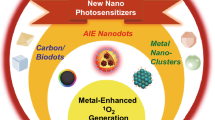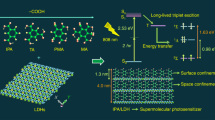Abstract
We demonstrate the potential application of silver-pectin nanoparticles on photodynamic therapy, on a solution-base platform. Photodynamic therapy is a medical technique which uses a combination of photosensitizing drugs and light to induce selective damage on the target tissue, by electronically excited and highly reactive singlet state of oxygen. Metal enhanced singlet oxygen generation in riboflavin water solution with silver-pectin nanoparticles was observed and quantified. Here 13 nm silver nanospheres enclosed by a pectin layer were synthesized and it interaction with riboflavin molecule was analyzed. Pectin, a complex carbohydrate found in plants primary cell walls, was used to increase the biocompatibility of the silver nanoparticles and to improve metal enhanced singlet oxygen generation (28.5 %) and metal-enhanced fluorescence (30.7 %) processes at room temperature. The singlet oxygen sensor fluorescent green reagent was used to quantify the enhancement of the riboflavin singlet oxygen production induced by the silver colloid. We report a 1.7-fold increase of riboflavin emission and a 1.8-fold enhancement of singlet oxygen production.




Similar content being viewed by others
References
Wainwright M (1998) Photodynamic antimicrobial chemotherapy (PACT). J Antimicrob Chemoth 42:13–28. doi:10.1093/jac/42.1.13
Via LD, Magno SM (2001) Photochemotherapy in the treatment of cancer. Curr Med Chem 8:405–1418. doi:10.2174/0929867013372076
Simplício FI, Maionchi F, Hioka N (2002) Terapia fotodinâmica: aspectos farmacológicos, aplicações e avanços recentes no desenvolvimento de medicamentos. Quim Nova 25:801–807. doi:10.1590/S0100-40422002000500016
Calin MA, Parasca SV (2006) Photodynamic therapy in oncology. J Optoelectron Adv M 8:1173–1179
Meisel P, Kocher T (2005) Photodynamic therapy for periodontal diseases: state of the art. J Photochem Photobio B 79:159–170. doi:10.1016/j.jphotobiol.2004.11.023
Brown SB, Brown EA, Walke I (2004) The present and future role of photodynamic therapy in cancer treatment. Oncology 5:497–508. doi:10.1016/S1470-2045(04)01529-3
Wainwright M, Crossley KB (2004) Photosensitising agents—circumventing resistance and breaking down biofilms: a review. Int Biodeter Biodgr 53:119–126. doi:10.1016/j.ibiod.2003.11.006
O’Riordan K, Akilov OE, Hasan T (2005) The potential for photodynamic therapy in the treatment of localized infections. Photodiagn Photodyn Ther 2:247–262. doi:10.1016/S1572-1000(05)00099-2
Jori G, Fabris C, Soncin M, Ferro S, Coppellotti O, Dei D, Fantetti L, Chiti G, Roncucci G (2006) Photodynamic therapy in the treatment of microbial infections: basic principles and perspective applications. Laser Surg Med 38:468–481. doi:10.1002/lsm.20361
Boylet RW, Dolphin D (1996) Structure and biodistribution relationships of photodynamic sensitizers. Photochem Photobiol 64:469–485. doi:10.1111/j.1751-1097.1996.tb03093.x
Chan WM, Lam DSC, Lai TYY, Tam BSM, Liu DTL, Chan CKM (2003) Choroidal vascular remodelling in central serous chorioretinopathy after indocyanine green guided photodynamic therapy with verteporfin: a novel treatment at the primary disease level. Br J Ophthalmol 87:1453–1458. doi:10.1136/bjo.87.12.1453
Zhang Y, Aslan K, Previte MJR, Geddes CD (2007) Metal-enhanced singlet oxygen generation: a consequence of plasmon enhanced triplet yields. J Fluoresc 17:345–349. doi:10.1007/s10895-007-0196-y
Ion RM, Planner A, Wicktowicz K, Frakowiak D (1998) The incorporation of various porphyrins into blood cells measures via flow cytometry, absorption and emission spectroscopy. Acta Biochim Pol 45:833–845
Ochsner M (1997) New trends in photobiology (Invited review): photophysical and photobiological processes in the photodynamic therapy of tumours. J Photochem Photobio B 39:1–18. doi:10.1016/S1011-1344(96)07428-3
Ion RM (2007) Photodynamic therapy (PDT): a photochemical concept with medical applications. Rev Roum Chim 52:1093–1102. doi:10.1002/chin.200849276
Bonnett R, White RD, Winfield UJ, Berenbaum MC (1989) Hydroporphyrins of the meso-tetra(hydroxyphenyl)porphyrin series as tumour photosensitizers. Biochem J 261:277–280
Allison RR, Downie GH, Cuenca R, Hu XH, Childs CJH, Sibata CH (2004) Photosensitizers in clinical PDT. Photodiagn Photodyn Ther 1:27–42. doi:10.1016/S1572-1000(04)00007-9
Tang W, Xu H, Kopelman R, Philbert MA (2005) Photodynamic characterization and In vitro application of methylene blue-containing nanoparticles plataforms. Photochem Photobiol 81:242–249. doi:10.1111/j.1751-1097.2005.tb00181.x
Martins SAR, Combs JC, Noguera G, Camacho W, Wittmann P, Walther R, Cano M, Dick J, Behrens A (2008) Antimicrobial efficacy of riboflavin/UVA combination (365 nm) In vitro for bacterial and fungal isolates: a potential new treatment for infectious keratitis. IOVS 49:3402–3408. doi:10.1167/iovs.07-1592
Powers HJ (2003) Riboflavin (vitamin B-2) and health. Am J Clin Nutr 77:1352–1360
Pass HI (1993) Photodynamic therapy in oncology: mechanisms and clinical use. J Natl Cancer I 85:443–456. doi:10.1093/jnci/85.6.443
Dougherty TJ, Gomer CJ, Henderson BW, Jori G, Kessel D, Korbelik M, Moan J, Peng Q (1998) Photodynamic therapy. J Natl Cancer I 90:889–905. doi:10.1093/jnci/90.12.889
Zhang Y, Aslan K, Previte MJR, Geddes CD (2008) Plasmonic engineering of singlet oxygen generation. PNAS 105:1798–1802. doi:10.1073/pnas.0709501105
Cai H, Xu Y, Zhu N, He P, Fang Y (2002) An electrochemical DNA hybridization detection assay based on a silver nanoparticle label. Analyst 127:803–808. doi:10.1039/B200555G
Liu J, Lu Y (2003) A colorimetric lead biosensor using DNAzyme-directed assembly of gold nanoparticles. J Am Chem Soc 125:6642–6643. doi:10.1021/ja034775u
Sönnichsen C, Reinhard BM, Liphardt J, Alivisatos AP (2005) A molecular ruler based on plasmon coupling of single gold and silver nanoparticles. Nat Biotechnol 23:741–754. doi:10.1038/nbt1100
Hu Y, Fine DH, Tasciotti E, Bouamrani A, Ferrari M (2011) Nanodevices in diagnostics. Nanomed Nanobiotech 3:11–32. doi:10.1002/wnan.82
Lakowicz JR, Shen B, Gryczynski Z, D’auria S, Gryczynfor I (2001) Intrinsic fluorescence from DNA can be enhanced by metallic particles. Biochem Biophys Res Co 286:875–879. doi:10.1006/bbrc.2001.5445
Geddes CD, Lakowicz JR (2002) Metal-enhanced fluorescence. J Fluoresc 12:121–129. doi:10.1023/A:1016875709579
Lakowicz JR, Shen Y, D’Auria S, Malicka J, Fang J, Gryczynski Z, Gryczynsk I (2002) Radiative decay engineering 2: effects of silver island films on fluorescence intensity, lifetimes, and resonance energy transfer. Anal Biochem 301:261–277. doi:10.1006/abio.2001.5503
Malicka J, Gryczynski I, Lakowicz JR (2003) DNA hybridization assays using metal-enhanced fluorescence. Biochem Bioph Res Co 20:213–218. doi:10.1016/S0006-291X(03)00935-5
Rativa D, Gomes ASL, Wachsmann-Hogiu S, Farkas DL, Araujo RE (2008) Nonlinear excitation of Tryptophan emission enhanced by silver nanoparticles. J Fluoresc 18:1151–1155. doi:10.1007/s10895-008-0366-6
Hirsch LR, Stafford RJ, Bankson JA, Sershen SR, Rivera B, Price RE, Hazle JD, Halas NJ, West JL (2003) Nanoshell-mediated near-infrared thermal therapy of tumors under magnetic resonance guidance. PNAS 100:13549–13554. doi:10.1073/pnas.2232479100
Loo C, Lin A, Hirsch L, Lee MH, Barton J, Halas N, West J, Drezek R (2004) Nanoshell-enabled photonics-based imaging and therapy of cancer. Technol Cancer Res Treat 3:33–40
Loo C, Lowery A, Halas N, West J, Drezek R (2005) Immunotargeted nanoshells for integrated cancer imaging and therapy. Nano Lett 5:709–711. doi:10.1021/nl050127s
Skrabalak SE, Chen J, Sun Y, Lu X, Au L, Cobley LM, Xia Y (2008) Gold nanocages: synthesis, properties, and applications. Accounts Chem Res 41:1587–1595. doi:10.1021/ar800018v
Landfester K, Musyanovych A, Mailander V (2010) From polymeric particles to multifunctional nanocapsules for biomedical applications using the miniemulsion process. J Polym Sci A 48:493–515. doi:10.1002/pola.23786
Fishman M, Jen JJ (1986) Chemistry and function of pectins. American Chemical Society, Washington
Baier J, Maisch T, Maier M, Engel E, Landthaler M, Baumler W (2006) Singlet oxygen generation by UVA light exposure of endogenous photosensitizers. Biophys J 91:1452–1459. doi:10.1529/biophysj.106.082388
Penzer GR, Radda GK (1967) The chemistry and biological function of isoalloxazines (Flavines). Q Rev Chem Soc 21:47–65
Oster BG, Bellin JS, Holmstrom B (1962) Photochemistry of riboflavin. Cell Mol Life Sci 18:249–296. doi:10.1007/BF02148213
Steele RH, Cusachs LC (1967) Energy terms of oxygen and riboflavin – a biological quantum leader? Nature 213:800–801. doi:10.1038/213800a0
Molecular Probes (2004) Product information http://probesinvitrogen.com/media/pis/mp36002.pdf?id=mp36002
Flors C, Fryer J, Waring J, Reeder B, Bechtold U, Mullineaux PM, Nonell S, Wilson MT, Baker R (2006) Imaging the production of singlet oxygen in vivo using a new fluorescent sensor, Singlet Oxygen Sensor Green. J Exp Bot 57:1725–1734. doi:10.1093/jxb/erj181
Kumar S, Adams WW (1990) Electron beam damage in high temperature polymers. Polymer 31:15–19. doi:10.1016/0032-3861(90)90341-U
Lakowicz JR (2005) Radiative decay engineering 5: metal-enhanced fluorescence and plasmon emission. Anal Biochem 15:171–194. doi:10.1016/j.ab.2004.11.026
Zhang Y, Aslan K, Malyn SN, Geddes CD (2006) Metal-enhanced phosphorescence (MEP). Chem Phys Lett 427:432–437. doi:10.1016/j.cplett.2006.06.078
Zhang Y, Aslan K, Previte MJR, Malyn SN, Geddes CD (2006) Metal-enhanced phosphorescence: interpretation in terms of triplet-coupled radiating plasmons. J Phys Chem B 110:25108–25114. doi:10.1021/jp065261v
Acknowledgments
We thank the Conselho Nacional de Desenvolvimento Científico e Tecnológico (CNPq) for financial support through the National Institute of Science and Technology of Photonics (INCT de Fotônica), to the Programa de Núcleos de Excelência (PRONEX-FACEPE/CNPq). We acknowledge the Laboratory of Non Conventional Polymers (UFPE) for the ISS equipment used.
Author information
Authors and Affiliations
Corresponding author
Rights and permissions
About this article
Cite this article
de Melo, L.S.A., Gomes, A.S.L., Saska, S. et al. Singlet Oxygen Generation Enhanced by Silver-Pectin Nanoparticles. J Fluoresc 22, 1633–1638 (2012). https://doi.org/10.1007/s10895-012-1107-4
Received:
Accepted:
Published:
Issue Date:
DOI: https://doi.org/10.1007/s10895-012-1107-4




